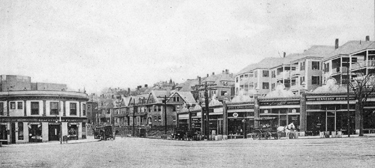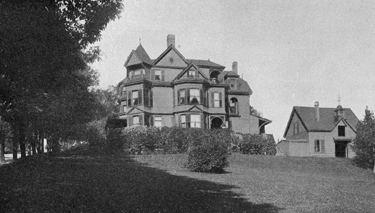Washington Square is nestled at the base of Brookline's two largest hills, Aspinwall and Corey, where Beacon and Washington Streets come together. Washington Street confirms the popular folklore that our jumble of streets results from their origins as cow paths. Laid out in 1657 to carry cattle from Brookline Village to the stockyards of Brighton and Watertown, Washington Street was one of Brookline's first roads, and remained unsettled until the 1700's. A reminder of this former life can be seen in the form of a historic plaque on Brighton's Market Street just north of Washington Street. It marks the site of one of the oldest and longest lasting Boston stockyards.
Orchard Roots
Long before T cars rumbled down Beacon Street, the hills surrounding Washington Square were sparsely settled with farmsteads. Hilly topography, distance from Boston, and limited transportation routes made the land unsuitable for denser settlement, and conspired to create a bucolic landscape of rolling hills dotted with cows, orchards, and woodlands. Corey Hill's namesake, Timothy Corey of Weston, settled on the hill in 1760. His descendants operated a dairy farm, sending a wagon loaded with milk to Faneuil Hall daily. A description written in 1800 of the Corey land evokes the image of "a natural growth of trees and orchards laden with fruit." The remote character of the area in the early 1790's made it a suitable location for rural enterprises, such as the tannery established on swampland near Fairbanks Road by two men from Dorchester, John Robinson and Enos Withington.
As with other parts of Brookline, the 1851 construction of Beacon Street changed everything. Now that it was more accessible, Washington Square's lovely rolling landscape became attractive to prosperous Boston businessmen as an ideal location for their large country estates. The most famous of these being Stonehurst, built in 1890 by Eben Jordan, of Boston's Jordan Marsh department store. Remnants of Stonehurst are still visible today in the form of the cobblestone columns and slate stairs at the start of Summit Path on Beacon Street. Eben Jordan eventually bought much of the land on the southwest slope of Corey Hill for building and development.
Tracing the history of a piece of the Corey land illustrates the hill's evolution during the 1800's. In 1843 Deacon Corey sold 40 acres of land on Washington Street to James Bartlett (Bartlett Crescent is named after him) for $10,000, who resided on his farm for 30 years. He then sold his land to Eben Jordan, who bought it for a price of $115,000 and laid it out as housing lots, which he sold slowly over time.
Rapid Housing DevelopmentOnce Beacon Street was widened in 1887, the demand for housing boomed and the development of Corey Hill and the Washington Square area began in earnest. Many apartment blocks were built along Beacon Street at this time. Outstanding examples of those that remain are the magnificent 1907 Stoneholm, a Beaux Arts masterpiece designed by Arthur Bowditch, which is located at 1514 Beacon Street on the crest of Corey Hill, and The Majestic, built in 1896 at 1569-71 Beacon Street. Large land parcels on Corey Hill were divided into building lots and developed in rapid succession, allowing the street and path system to be laid out with a cohesive pattern and structure. Roadways are terraced onto the hillside, running parallel to the contours. The three pedestrian paths provide shortcuts directly up and down the slope of the hill.
Enjoying the View
Summit Avenue had been laid out in 1868; at first to carry produce and equipment to and from the farms, its route traveling directly up and over the crest of the hill. Local residents have long appreciated the panoramic view from the top of the 260 foot hill. The popularity of making the sightseeing excursion to the top of the hill spurred the paving of Summit Avenue, and a wooden plank walkway was put in for pedestrians. 400 visitors were counted on one Sunday afternoon. The draw of the hilltop extended beyond Brookline, attracting such local luminaries as Harvard President Charles W. Eliot and the Swiss-born naturalist, Louis Agassiz. The health-giving benefits of the pleasant breezes and open spaces of the hilltop were pursued, and several health-related institutions joined the country estates on the hill. The town government assured continued public access to the view by purchasing two pieces of land at the top of the hill in 1900 and 1915 for a park. As demand for housing grew with the advent of the trolley on Beacon Street, denser development of single-family homes and apartments filled in along the terraced roads perched on the hillside.
Decades of Commercial Growth
Commercial development came relatively late to the area, with one of the first commercial buildings being built on the southeast corner in 1898. This building, which now houses Athan's, was once home to stores, offices, and a concert hall. By the 1920's and 30's, increased housing density created demand for commercial establishments. Beacon Street became the focus for this commercial development, with many prominent structures reflecting the Art Deco style that was popular at the time. By this time, the era of the large single-family estate on the hill was coming to an end.
The 1950's and 60's brought the modernist apartment tower to Beacon Street, with several massive buildings replacing the large single-family estates and the smaller, older apartments that were there. The effects of this trend can be found in cities around the globe, and Brookline is no exception.
Recently, several new businesses have renovated their historic locations in Washington Square, bringing a renewed energy to the area. Significant new housing development on Beacon Street has brought new residents as well. Outdoor seating at a number of eateries has proved especially popular for neighborhood residents and visitors alike, giving the area an active and vibrant atmosphere.

